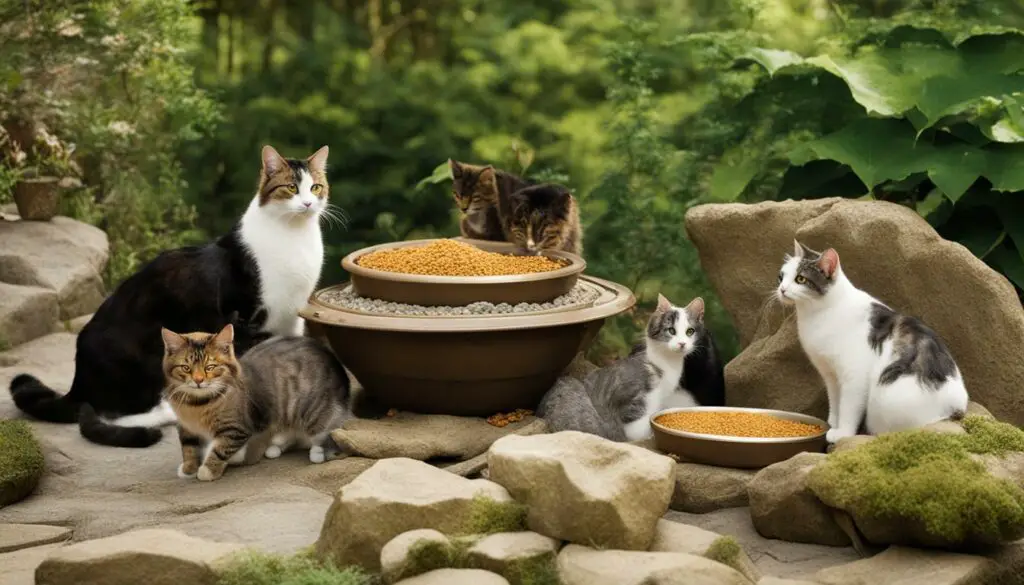Feeding outdoor cats is important for their health and well-being. In this guide, I will provide you with tips and advice on how to feed outdoor cats safely and effectively. By following these safe practices, you can ensure that your feline friends in the wild are well taken care of.
Key Takeaways:
- Establish a regular feeding schedule for outdoor cats to maintain their health and provide the necessary nutrition.
- Choose high-quality cat food that contains whole meat and avoids excessive grains or by-products.
- Keep the feeding area clean and in one location to promote the cats’ health and maintain good community relations.
- Adapt the feeding practices to changing seasons to ensure the cats’ well-being, such as providing shelter in winter and ample water sources in summer.
- Consider the role of vitamins and supplements in supporting the outdoor cats’ health, consulting with a veterinarian before introducing any new additions to their diet.
Importance of Regular Feeding Times
Establishing a regular feeding schedule is vital for the well-being of outdoor cats. By providing them with consistent meal times, you not only ensure they receive the necessary nutrition but also help maintain their overall health. Adult cats typically consume around 5.5 ounces of wet food and 2 ounces of dry food per day. However, it is important to adjust the amount based on their individual needs and appetite.
Observing the cats’ feeding behavior can help determine the right portion size for each meal. If the food disappears within 15 minutes or less, it may indicate that they need more food. On the other hand, if there is always leftover food after 30 minutes, it might suggest that the portion is too much. Regular feeding times allow you to monitor their intake and adjust accordingly.
Creating a consistent feeding routine also helps outdoor cats adapt to a predictable schedule, reducing stress and promoting a sense of security. Cats thrive on a sense of routine, and by providing them with reliable meal times, you establish a stable environment that contributes to their overall well-being.
Importance of Regular Feeding Times
| Feeding Time | Food Portion |
|---|---|
| Morning | 5.5 ounces of wet food |
| Evening | 2 ounces of dry food |
Wet Food vs. Dry Food
When it comes to feeding outdoor cats, the choice between wet food and dry food is a common dilemma. Both options have their merits and can provide a balanced diet for our feline friends. Wet food, such as canned cat food, is known to contain more nutrients compared to its dry counterpart. This is because the canning process helps to retain the natural juices and flavors, as well as the essential vitamins and minerals. Additionally, wet food has a higher moisture content, which can help keep outdoor cats well-hydrated, especially during hot weather.
On the other hand, dry food, or kibble, is equally nutritious and has its own advantages. Dry food is more convenient and can be easily stored for longer periods without spoiling. It also helps to promote dental health as the crunchiness of the kibble can help remove plaque and tartar buildup. However, it is important to note that cats have a low thirst drive, and feeding them solely dry food may not provide adequate hydration.
Ultimately, the choice between wet food and dry food depends on your outdoor cat’s preferences and specific dietary needs. It is essential to select high-quality cat food that contains whole meat as the primary ingredient and avoids excessive grains or by-products. Consulting with a veterinarian can also provide valuable insights into the best food options for your outdoor cats.
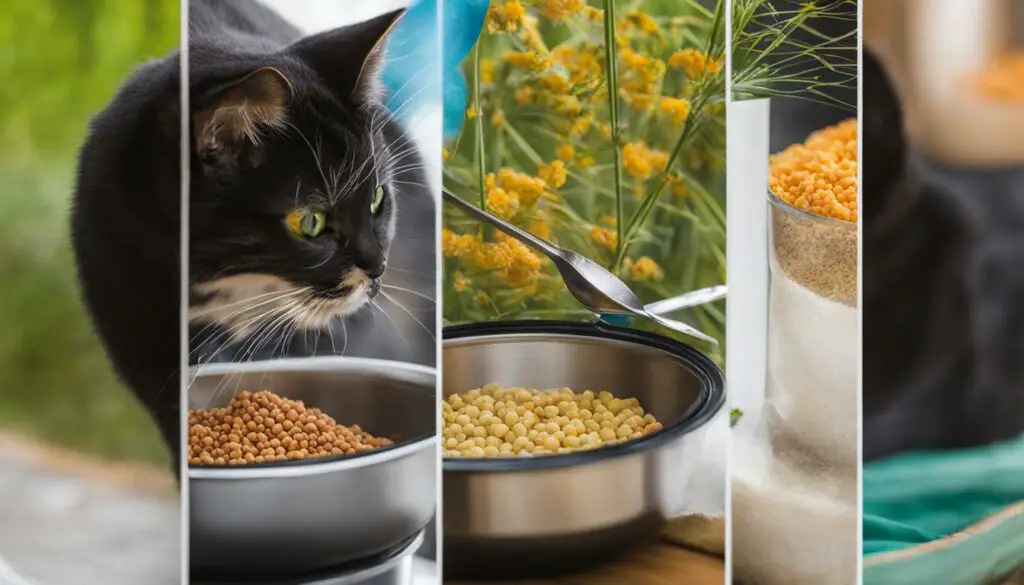
The Benefits of Wet Food:
- Higher nutrient content
- Increased moisture intake
- Promotes hydration, especially in hot weather
The Advantages of Dry Food:
- Convenient storage and longer shelf life
- Promotes dental health
Tips for Selecting Cat Food:
- Choose high-quality options with whole meat as the main ingredient
- Avoid excessive grains or by-products
- Consult with a veterinarian for personalized recommendations
Proper Feeding Habits
When it comes to feeding outdoor cats, establishing proper feeding habits is crucial for their health and well-being. Here are some important tips to keep in mind:
- Do not leave uneaten food out for more than 30 minutes. This helps prevent attracting bugs and pests to the feeding area.
- Keep the feeding area clean and tidy. Regularly remove any leftover food and clean the bowls or dishes to maintain hygiene.
- Designate a specific location for feeding. This helps create a sense of routine for the cats and prevents them from wandering into other areas.
- Understand that cats may have different feeding habits. Senior cats often have priority in a cat community’s social hierarchy and may eat before others.
By following these proper feeding habits, you can ensure that outdoor cats are provided with fresh food, a clean feeding area, and a consistent feeding routine.

“Proper feeding habits are essential for the well-being of outdoor cats.”
Adapting to Changing Seasons
When it comes to feeding outdoor cats, it’s important to consider the changing seasons and make necessary adjustments to ensure their well-being. Different weather conditions require different approaches to cat feeding. By following these cat feeding tips, you can help ensure that outdoor cats stay healthy and nourished throughout the year.
Winter Feeding Adjustments
During the winter months, it’s essential to make certain adjustments to prevent the cat’s food from freezing and to provide shelter for them. Freezing temperatures can make it difficult for cats to find adequate food, and exposure to cold weather can be harmful to their health. To keep their food from freezing, you can use insulated bowls or heated feeding stations. Additionally, providing protective shelter, such as insulated cat houses or blankets, can help keep the cats warm and safe during the colder months.
Summer Hydration
In the summer, it’s crucial to focus not only on food but also on keeping outdoor cats well-hydrated. Hot weather can lead to dehydration, which can be dangerous for cats. Ensure that there are ample water sources available for the cats, such as bowls of fresh water placed in shaded areas. You can also consider using water fountains or automatic waterers to ensure a continuous supply of fresh water throughout the day. Monitoring the water sources regularly to ensure they are clean and free from debris is also important for the cats’ health.
Year-round Adjustments
Throughout the year, it’s important to monitor the cats’ feeding habits and adjust accordingly. Some cats may have specific dietary needs or preferences, and it’s essential to consider these factors when selecting their food. By observing their eating patterns and monitoring their overall health, you can make informed decisions about their diet. Regular veterinary check-ups are also crucial to ensure that any specific nutritional needs are met.
Table: Seasonal Cat Feeding Tips
| Season | Feeding Tips |
|---|---|
| Winter | Prevent food from freezing |
| Provide shelter for warmth | |
| Summer | Ensure access to fresh water |
| Keep water sources clean and plentiful | |
| Year-round | Monitor feeding habits and adjust as needed |
By adapting your cat feeding practices to the changing seasons, you can help ensure the well-being of outdoor cats and provide them with the nourishment they need to thrive.

The Best Food for Outdoor Cats
When it comes to providing the best nutrition for outdoor cats, choosing the right cat food is crucial. High-quality cat food plays a vital role in their overall health and well-being. By providing outdoor cats with a balanced and nutritious diet, we can ensure they have the energy and nutrients they need to thrive in their outdoor environment.
So, what is the best food for outdoor cats? It is recommended to opt for cat food that contains whole meat as the primary ingredient. This ensures that the cats are getting the essential protein they need for muscle development and overall health. Avoid cat foods that contain excessive grains or by-products, as these may not provide the necessary nutrients for cats.
“Choosing the right cat food is crucial for outdoor cats’ nutrition and overall health.”
When selecting cat food for outdoor cats, it is also important to consider their specific dietary needs. Outdoor cats lead more active lifestyles than indoor cats, so they may require a higher calorie intake to support their energy expenditure. Look for cat foods that are specifically formulated for outdoor or active cats to meet their increased nutritional requirements.
| Cat Food Brand | Product Description | Key Features |
|---|---|---|
| Purina ONE | Indoor Advantage | Contains real turkey as the main ingredient, helps minimize hairballs, promotes a healthy weight |
| Blue Buffalo | Wilderness Rocky Mountain Recipe | Features high-protein, grain-free formula with real meat, supports muscle development |
| Wellness CORE | Original Turkey & Chicken | Grain-free recipe, provides balanced nutrition, supports healthy skin and coat |
Remember to consult with your veterinarian for specific recommendations based on your outdoor cats’ individual needs. They can provide guidance on the best cat food brands and formulations for outdoor cats, taking into consideration factors such as age, activity level, and any existing health conditions.
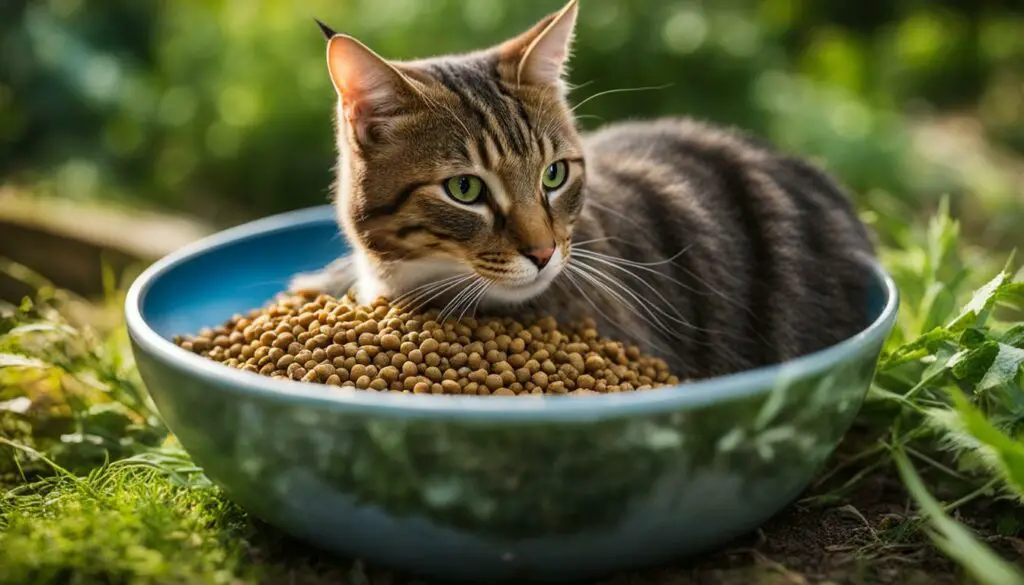
Importance of Water for Outdoor Cats
Ensuring that outdoor cats have access to clean water is crucial for their hydration and overall well-being. Adequate water intake is essential to prevent dehydration and maintain proper bodily functions. However, providing water for outdoor cats can pose unique challenges, especially during extreme weather conditions.
In the winter months, it is important to prevent water from freezing, as cats may struggle to find alternative water sources. To address this issue, consider using heated water bowls or placing water containers in insulated shelters. By implementing these measures, you can ensure that outdoor cats have access to clean, unfrozen water, reducing the risk of dehydration.
In the scorching summer heat, cats can easily become dehydrated. It is crucial to provide multiple water sources in shaded areas to prevent the water from becoming too warm. Additionally, consider using water fountains or elevated bowls to encourage cats to drink more water. Regularly monitor and refill the water containers to ensure a constant supply of clean, fresh water for outdoor cats.
| Outdoor Cat Water Tips |
|---|
| Place water containers in shaded areas to keep the water cool during summer months. |
| Consider using heated water bowls or insulated shelters to prevent water from freezing in the winter. |
| Use water fountains or elevated bowls to encourage cats to drink more water. |
| Regularly monitor and refill water containers to ensure a constant supply of clean, fresh water. |
By prioritizing the provision of clean, accessible water for outdoor cats, you can help prevent dehydration and promote their overall health and well-being. Remember to regularly clean and sanitize the water containers to prevent the growth of harmful bacteria and ensure that the water remains fresh and safe for consumption.
The Role of Vitamins and Supplements
When it comes to the health of outdoor cats, providing the right vitamins and supplements can play a significant role. Certain supplements can help support their overall well-being, especially during cold winters and times of stress. Two key supplements that can benefit outdoor cats are Vitamin C and D-mannose.
Vitamin C: This essential vitamin offers numerous health benefits for outdoor cats. It is known for its immune-boosting properties and can help protect cats from common illnesses and infections. Additionally, Vitamin C also aids in collagen production, which is crucial for maintaining healthy skin, joints, and connective tissues.
D-mannose: This supplement is particularly effective in preventing and treating urinary tract issues in cats. D-mannose is a naturally occurring sugar that helps inhibit the adhesion of harmful bacteria to the urinary tract walls. By incorporating D-mannose into their diet, outdoor cats can reduce the risk of urinary tract infections and maintain optimal urinary tract health.
Remember to always consult with a veterinarian before introducing any new vitamins or supplements to your outdoor cat’s diet. They can provide expert advice tailored to your cat’s specific needs and ensure that the supplements are safe and appropriate.
Choosing High-Quality Supplements
When selecting vitamins and supplements for outdoor cats, it is crucial to choose high-quality options that are specifically formulated for feline health. Look for reputable brands that use natural ingredients, without any artificial additives or fillers. It is also important to follow the recommended dosage instructions provided by the manufacturer or your veterinarian.
By providing the right vitamins and supplements, you can help support the overall health and well-being of outdoor cats, ensuring they thrive in their outdoor environment.
| Vitamin/Supplement | Benefits |
|---|---|
| Vitamin C | – Boosts immune system – Supports healthy skin and connective tissues |
| D-mannose | – Prevents and treats urinary tract issues – Maintains optimal urinary tract health |

Creating Feeding Stations
Feeding stations provide numerous benefits for outdoor cats, ensuring their food is protected and accessible in various weather conditions. Creating a designated feeding area can help maintain the cleanliness of the food and prevent it from attracting unwanted pests. It also allows caretakers to easily monitor the cats’ food intake and health. By implementing a sheltered feeding station, we can ensure that outdoor cats receive the nutrition they need while promoting their overall well-being.
Benefits of a Cat Feeding Station
A cat feeding station offers a range of advantages for both the cats and the caretakers. Firstly, it helps protect the food from rain, wind, and snow, ensuring that the cats always have access to fresh and dry food. Additionally, by providing a sheltered feeding area, we can prevent other animals from stealing the cats’ food, allowing them to eat in peace. Feeding stations also contribute to the overall cleanliness of the environment, as it consolidates the feeding area in one location, reducing the chances of scattered food and litter.
Designing a Feeding Station
Creating a simple and effective feeding station for outdoor cats can be done using accessible materials. One option is to repurpose a large Rubbermaid storage bin by cutting out an entrance hole and placing the food and water dishes inside. This provides protection from the elements while still allowing easy access for the cats. For those looking for a more permanent structure, pre-made wooden feeding stations are available, equipped with features like elevated platforms and roof covers.
Ensuring Accessibility and Privacy
When locating the feeding station, it is crucial to strike a balance between accessibility for caretakers and privacy for the cats. Choose a spot that is easily accessible for daily food replenishment and monitoring, but hidden or inaccessible to the public to reduce the risk of interference or theft. By creating a designated feeding area that offers both protection and privacy, we can provide outdoor cats with a reliable and secure source of nourishment.
| Benefits of a Cat Feeding Station | Designing a Feeding Station | Ensuring Accessibility and Privacy |
|---|---|---|
| Protects food from weather conditions | Repurpose a Rubbermaid storage bin or use a wooden feeding station | Choose a location accessible to caretakers but hidden from the public |
| Prevents other animals from stealing food | Place food and water dishes inside the feeding station | Balance accessibility for caretakers with privacy for cats |
| Reduces chances of scattered food and litter | Provide a roof cover or elevated platform for added protection |
Dealing with Common Feeding Issues
Feeding outdoor cats can sometimes attract unwanted wildlife and pests, such as raccoons, pigeons, and ants. It’s important to take proactive measures to address these common feeding issues to ensure the well-being of the cats and maintain good relations with the community.
When it comes to wildlife, one effective strategy is to feed the cats during daylight hours and promptly remove any leftover food. This helps to minimize the attraction of nocturnal animals like raccoons or opossums. By keeping a close eye on the feeding area and promptly removing any uneaten food, you can help prevent wildlife intrusions.
Pigeons can also be a nuisance when it comes to outdoor cat feeding. To deter pigeons from eating the cats’ food, consider feeding the cats at night when pigeons are less active. Another option is to use feeding stations with pigeon flaps, which allow the cats to access the food while preventing pigeons from getting to it.
Ants and other insects are common around feeding areas, particularly if food or water spills occur. To control ants, you can create a moat around the feeding station using water, as ants are unable to cross the water barrier. Additionally, using ant-proof bowls can help prevent ants from reaching the food. Keeping the feeding area clean and free of spills will also discourage insects from being attracted to the area.
Table: Dealing with Common Feeding Issues
| Issue | Solution |
|---|---|
| Wildlife Intrusions (Raccoons, Opossums) | Feed cats during daylight hours and promptly remove leftover food. |
| Pigeons Eating Cats’ Food | Feed cats at night or use feeding stations with pigeon flaps. |
| Ants and Insects | Create a moat with water or use ant-proof bowls. Keep the feeding area clean. |
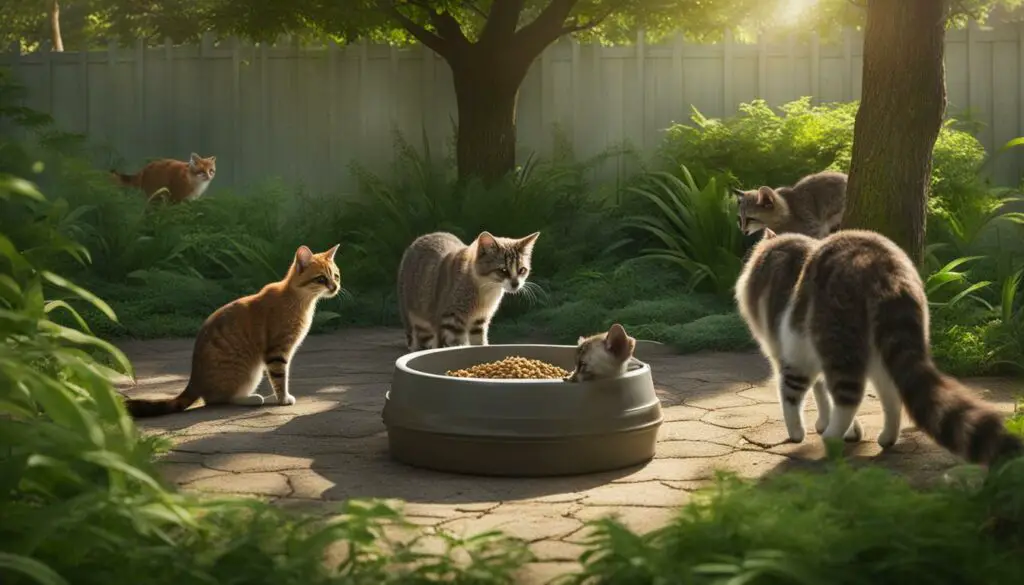
By implementing these strategies and addressing common feeding issues, you can help ensure that outdoor cats receive the food they need while minimizing disruptions from wildlife, pigeons, ants, and other pests. This not only benefits the cats’ health and well-being but also helps to maintain a positive relationship with the community.
The Humane Approach: Trap-Neuter-Return (TNR)
Trap-Neuter-Return (TNR) is a proven and humane method for managing community cat populations. By implementing TNR programs, we can effectively control the cat population, reduce the number of kittens born, and improve the overall well-being of outdoor cats. TNR involves trapping community cats, neutering or spaying them, and then returning them to their original location.
TNR has several advantages over other methods of population control. Firstly, it prevents the unnecessary euthanasia of healthy cats. Many animal shelters have historically euthanized outdoor cats brought in by well-meaning individuals due to their unadoptable status. With TNR, we can give these cats a chance to live out their lives in their natural environment.
Furthermore, TNR stabilizes colony populations over time. By neutering and spaying community cats, we can prevent new kittens from being born, which helps reduce the overall cat population in a humane and ethical manner. This approach also helps reduce nuisance behaviors associated with mating, such as spraying or fighting, making the cats better neighbors to the community.
Benefits of Trap-Neuter-Return (TNR)
The benefits of TNR are numerous. Firstly, it is a cost-effective solution compared to other population control methods. TNR programs typically rely on donations and the support of volunteers, making it a sustainable approach for managing community cats. Secondly, TNR improves the cats’ quality of life by ensuring they are no longer reproducing, reducing the risks associated with mating and pregnancy complications. Lastly, TNR fosters a compassionate and responsible community that recognizes the value of cats as sentient beings who deserve our care and respect.
| Advantages of TNR | Disadvantages of TNR |
|---|---|
|
|
TNR is widely supported by credible animal protection organizations as the most effective and ethical method for managing community cat populations. It is important to collaborate with local shelters, animal welfare groups, and fellow caregivers to ensure the success of TNR efforts. Together, we can make a positive difference in the lives of outdoor cats and create a more compassionate community for both humans and feline friends.
The Role of Shelters in TNR
When it comes to managing community cat populations, animal shelters play a crucial role in supporting Trap-Neuter-Return (TNR) efforts. Traditionally, bringing outdoor cats to shelters resulted in euthanasia due to their unadoptable status. However, many shelters are now embracing humane policies and recognizing the importance of TNR in controlling cat populations while improving the lives of these community cats.
Some shelters have even developed their own TNR programs, such as Shelter-Neuter-Return (SNR) or Return to Field (RTF). These programs focus on trapping community cats, sterilizing them, and returning them to their original location instead of euthanizing them. By doing so, shelters not only prevent the birth of new kittens but also stabilize cat populations in a humane and compassionate way.
It is essential to understand your local shelter’s policies regarding community cats before taking any action. By working with your local shelter and engaging in TNR efforts, you can contribute to the well-being of community cats and help alleviate the challenges they face in the wild.
| Shelter | TNR Program | Contact Information |
|---|---|---|
| ABC Animal Shelter | SNR | Phone: 555-1234 Email: [email protected] |
| XYZ Animal Rescue | RTF | Phone: 555-5678 Email: [email protected] |
Image source: seo writing.ai
Getting Involved: Alley Cat Allies and TNR Resources
When it comes to feeding and caring for outdoor cats, collaborating with experienced organizations can make a significant difference. Alley Cat Allies is a global leader in advocating for the humane treatment of cats and provides valuable resources for Trap-Neuter-Return (TNR) programs. By getting involved with Alley Cat Allies, you can access guidance on implementing TNR, educating your community, and connecting with their extensive Feral Friends Network.
The Feral Friends Network is an invaluable resource that comprises individuals with expertise in TNR efforts. These dedicated individuals can provide assistance in various ways, such as loaning out humane traps, offering advice on trapping techniques, or providing veterinary services. By joining forces with the Feral Friends Network, you can enhance your TNR efforts and ensure the well-being of community cats.

Alley Cat Allies’ commitment to cat welfare extends beyond TNR. They actively engage in community education and awareness, promoting a compassionate approach to outdoor cats. Through their resources, you can access educational materials to distribute within your community, helping to foster understanding and cooperation.
If you are passionate about assisting community cats and implementing TNR, Alley Cat Allies is an organization that can provide you with the tools and support you need. Their comprehensive resources, including the Feral Friends Network, ensure that you are not alone in your efforts to make a positive impact on the lives of outdoor cats.
Preparing for Trapping Cats
When it comes to trapping outdoor cats as part of a Trap-Neuter-Return (TNR) program, careful preparation is essential for a successful outcome. Trapping community cats can be a challenging task, as they are typically wary of people and may exhibit cautious behavior. To ensure the safety of both the cats and the trappers, it is important to follow proper procedures and use humane trapping methods.
Gather the Necessary Equipment
Before embarking on a trapping mission, make sure you have all the necessary equipment on hand. Humane traps, such as box traps or drop traps, should be obtained. These traps allow for the safe capture of cats without causing them harm. Additionally, it is important to have a supply of bait that will entice the cats to enter the traps. Common bait options include wet cat food or strong-smelling treats.
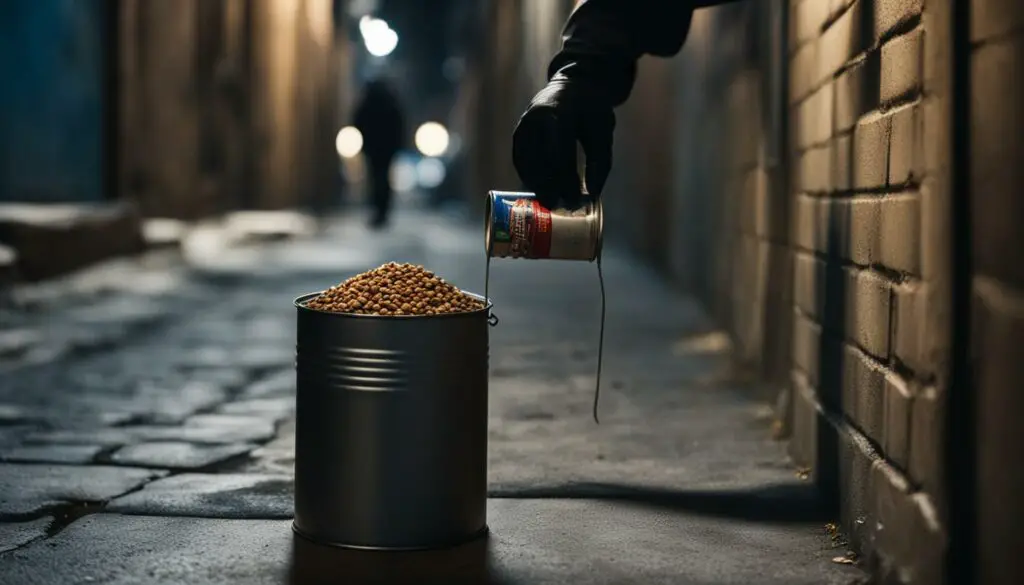
Select the Right Time and Place
Choosing the right time and place for trapping is crucial. Cats are more likely to be active during the early morning or evening hours, so these times are ideal for setting up traps. Additionally, consider the cats’ regular feeding schedule when determining the best time for trapping. As for the location, select an area where cats are known to frequent, such as near their feeding stations or shelter areas.
Enlist the Support of Others
Trapping community cats can be a challenging task to undertake alone. Enlist the support of fellow caregivers, neighbors, or volunteers who are familiar with the cats and their behaviors. Working together as a team can increase the effectiveness of the trapping efforts and ensure that all cats are safely captured. Additionally, having extra hands on deck can help manage any unexpected situations that may arise during the trapping process.
| Trapping Tips | Trapping Don’ts |
|---|---|
|
|
Trapping outdoor cats is an important step in the TNR process, as it allows for the cats to receive necessary medical care while preventing the birth of kittens. By ensuring proper preparation, utilizing humane trapping methods, and enlisting the support of others, you can contribute to the success of your TNR efforts and improve the lives of community cats.
Educating and Communicating with the Community
Building positive relationships with the community is crucial when conducting Trap-Neuter-Return (TNR) efforts. By educating neighbors and businesses about the benefits of TNR and your intentions, you can foster support for your initiatives. Open communication is key to gaining understanding and cooperation. Distribute educational materials, such as brochures or flyers, that explain the process and benefits of TNR in a clear and concise manner.
Collaboration with neighbors who may already be caring for the cats is also essential for a successful TNR program. By working together, you can share resources, knowledge, and experiences, creating a stronger network of caregivers. Establish regular meetings or communication channels to discuss any issues, concerns, or successes related to the community cats. This collaboration not only strengthens the impact of TNR efforts but also builds a sense of community around the care and welfare of outdoor cats.
Community Education
One effective way to educate the community about TNR is by organizing informational events or workshops. These can be held in local community centers, libraries, or schools, and can cover topics such as the importance of TNR, the impact of community cats on the environment, and the benefits of responsible cat ownership. Invite local experts, veterinarians, or representatives from animal welfare organizations to speak at these events, providing valuable insights and expertise.
Additionally, create an online presence through social media platforms or a dedicated website to raise awareness about TNR and the work being done in your community. Share success stories, resources, and educational content to engage a wider audience and encourage community involvement. By utilizing various communication channels, both offline and online, you can effectively communicate the importance of TNR and inspire others to get involved in cat welfare initiatives.
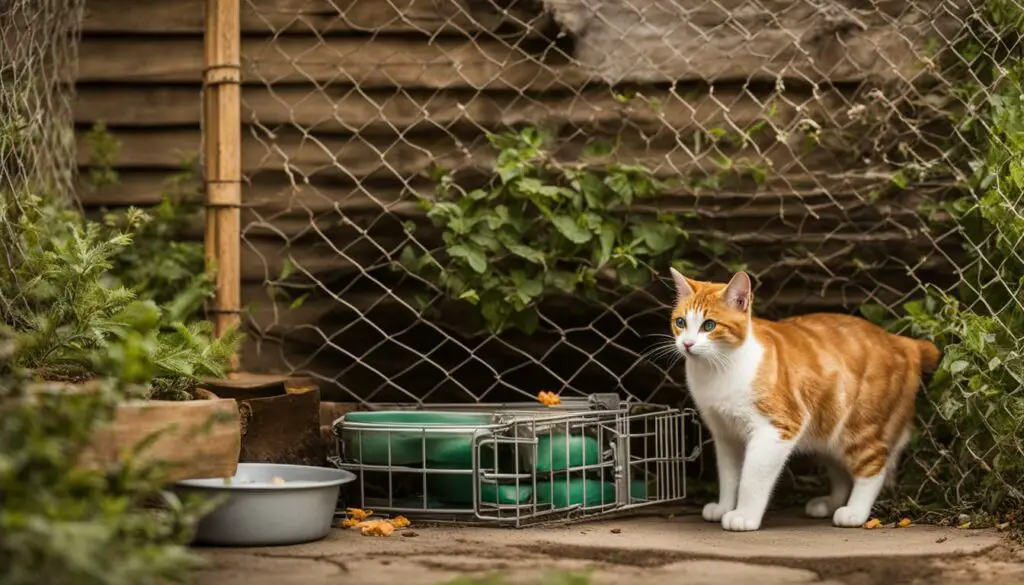
| Benefits of Community Education and Communication | Ways to Achieve Community Involvement |
|---|---|
|
|
Conclusion
Feeding outdoor cats is a responsibility that I take seriously. By following safe practices, we can ensure the well-being and welfare of these feline friends in the wild. Establishing regular feeding times and providing proper nutrition and hydration are crucial for their health. Creating feeding stations and implementing Trap-Neuter-Return (TNR) programs also play a significant role in managing outdoor cat populations.
Through education and collaboration with the community, we can create a more compassionate environment for these cats. It is important to communicate openly, distribute educational materials, and explain the benefits of TNR to gain understanding and cooperation. By working together, we can make a positive impact on the lives of outdoor cats and promote their welfare.
Feeding outdoor cats is not just about providing food; it is about caring for their overall well-being. By practicing safe feeding habits, we can ensure that these cats have access to nutritious food, clean water, and a sheltered feeding area. By implementing TNR programs, we can prevent the birth of new kittens, stabilize cat populations, and improve the lives of community cats.
So let’s continue to be responsible caretakers for outdoor cats, following safe practices and promoting their welfare. By doing so, we can make a difference in the lives of these feline friends and create a world where they can thrive in harmony with their human neighbors.
FAQ
How much food should I feed outdoor cats?
Adult cats generally eat about 5.5 ounces of wet food and 2 ounces of dry food per day. Adjust the amount based on their eating habits.
Is wet food or dry food better for outdoor cats?
Both wet food and dry food can provide a balanced diet for outdoor cats. Wet food generally contains more nutrients, but both options can be nutritious.
How long should I leave food out for outdoor cats?
Do not leave uneaten food out for more than 30 minutes to prevent attracting bugs. Keep the feeding area clean and in one location for the cats’ health.
What adjustments should I make to the feeding routine during different seasons?
During winter, prevent food from freezing and provide shelter. In summer, keep cats hydrated with ample water sources.
What is the best food for feeding outdoor cats?
Choose high-quality cat food that contains whole meat and avoids excessive grains or by-products. Consult Kate Barrington’s article “What is the Best Food for Feeding Feral Cats?” for recommendations.
How do I ensure outdoor cats have access to clean water?
Prevent water from freezing in winter and provide ample water sources in summer. Use heated water bowls or shields to keep water available.
Should I give outdoor cats vitamins and supplements?
Vitamins and supplements can be beneficial, especially during cold winters and times of stress. Consult a veterinarian for guidance.
How do I create a feeding station for outdoor cats?
Use a Rubbermaid storage bin or pre-made wooden feeding station. Incorporate gravity feeders and automatic waterers for a steady food supply.
How can I prevent wildlife from eating the cats’ food?
Feed cats during daylight hours, remove leftover food, and use pigeon flaps or feed at night to deter wildlife. Control insects by creating a moat with water or using ant-proof bowls.
What is Trap-Neuter-Return (TNR) and why is it important?
TNR is a humane approach to managing community cat populations. It prevents new kittens, stabilizes populations, and improves cats’ lives. It is supported by credible organizations.
How do shelters support TNR efforts for community cats?
Many shelters now embrace humane policies and have their own TNR programs. Understand your local shelter’s policies before taking action.
What resources are available for TNR programs?
Alley Cat Allies is a global leader in advocating for the humane treatment of cats. They provide resources, education, and connections through the Feral Friends Network.
How do I prepare for trapping outdoor cats?
Use humane traps, avoid handling cats, and plan according to the specific colony location. Enlist the support of neighbors and fellow caregivers.
How do I educate and communicate with the community about TNR?
Communicate openly, distribute educational materials, and explain the benefits of TNR. Collaborate with neighbors who may already be caring for the cats.
How can I contribute to the well-being of outdoor cats?
By following safe feeding practices, creating feeding stations, and supporting TNR programs, we can promote the well-being and welfare of outdoor cats.

